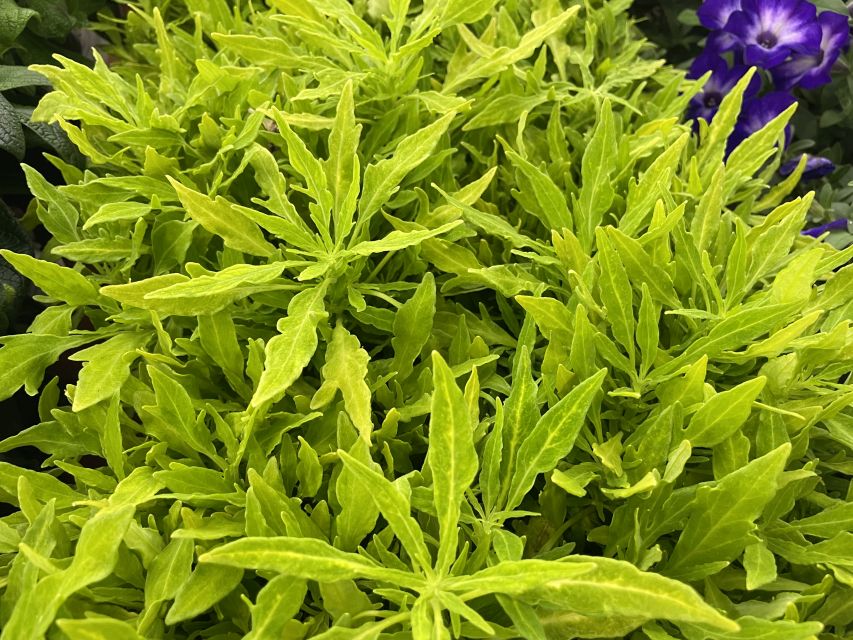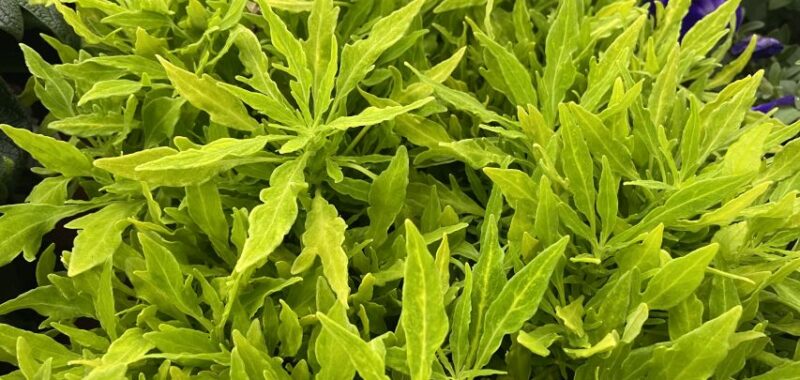
Coleus ‘ColorBlaze Mini Me Chartreuse’ (Proven Winners) Photo: Greenhouse Grower
Coleus has always been a popular foliage plant for shady spots, but more and more sun-tolerant varieties are available yearly, with breeders putting forth a big effort to satisfy the demand. Coleus have moved out of the shade garden and new varieties can be planted in sun or shade with equal success.
We chatted with a few experts to get a sample of this year’s exciting new offerings and some pointers on growing new coleus lines in the greenhouse.
A Sun-Loving Coleus Revolution
The days of sun-scorched coleus are drawing to an end. “Believe it or not, we’ve got a sun plant that loves the heat and doesn’t wilt. It’s incredible. It’s a new set of genetics,” says Steve Rinehart, Manager, Kientzler North America.
Skeptical of what sun-tolerant meant for coleus, Greenhouse Grower asked about the trials and selection process when bringing new varieties to market. “It’s right from the start,” Rinehart explains. “The selections are grown in the sun, and all the seedlings are subject to Florida sun immediately. We’re selecting material that doesn’t wilt in the Florida sun.”
But don’t think these plants won’t perform in the shade. “We want people to be able to use them in full sun and in shade,” says Kevin Hurd, Vice President of Product Development at Proven Winners. “They’re an anywhere plant at this point.”
Varieties are selected based on branching, late (or no) flowering, and shade performance. “We look for that late to flower plant, and then everybody is looking for what’s the next best color that really catches people’s eye — bolder colors are doing better than muted ones,” says Arnetia Verbeek Jackson, North American Product Manager, Specialty Annuals & Pelargonium at Dümmen Orange.
It wouldn’t be an article about coleus without some hot new varieties to tease your eyes. Check out a few new release favorites and high performers. They’re all sun tolerant and also do well in shady locations for traditional coleus plantings.

Coleus ‘Skeletal’ (Kientzler North America) Photo: Greenhouse Grower
Growing Coleus Liners for Customers
Coleus is a quick turnaround time crop in the greenhouse. Since there’s no need to wait for flowers, you can have a salable plant in a few weeks. Here are a few tips from the experts on getting these new coleus varieties finished fast and gorgeous.
John Gaydos, Director of Product Development & Promotion at Proven Winners, recommends moderate to high light levels (2,500 foot-candles to 5,000 foot-candles). No shade is required.
“Put it in some of your best-lit houses. That’s where I’d put it,” says Rinehart. As soon as it’s out of propagation, give it more light. The new varieties can handle it.
“Coleus are fast-growing plants. Following a pinch, the side shoots immediately begin to develop,” says Gaydos. Adequate spacing allows for the side shoots to develop and elongate slowly.
Air circulation is also critical. “Coleus can be sensitive to downy mildew, and this is especially true in coleus with chartreuse foliage colors. A spaced crop avoids trapped warm air and higher humidity and provides a better environment to avoid downy mildew altogether,” says Gaydos.
“They don’t like to be below 60°F. It’ll stunt them a little bit. Keep the greenhouse a little warmer overnight,” says Jackson. Rinehart agrees about nighttime temperatures, saying he would like to see growers keep the greenhouse at 60°F or higher overnight.
Fertigation doesn’t need to be altered just because coleus are sun-lovers. Rinehart explains that if you’ve had success growing other coleus varieties, you should use the same fertilizer regime.
However, that doesn’t mean no fertilizer is needed. “Our opinion is that, if you don’t fertilize, we think it alters some colors. When you have fertilizer, the colors are crisper and the patterns are easier to see.”
Gaydos advises avoiding high urea forms of nitrogen, especially during the cooler, darker growing months. “Many coleus will show their true colors when the nitrogen levels are 200 ppm or lower,” he says. “If there’s excessive nitrogen, some leaf colors will become ‘muddied’ or more olive green. When in doubt, run the coleus lean.”

Coleus Down Town Santa Monica (Dümmen Orange) Photo: Dümmen Orange
Putting Coleus to Work: Design Inspiration
For the past 15 years, coleus entering the market have been mostly high-light plants, impacting how they’re used in the landscape. Due to these changes, coleus are no longer confined to the shadier spots of the garden.
With new varieties in mounding, upright, and trailing shapes, all tolerant of full sun, coleus isn’t limited to being the filler in a container anymore. Choosing a series by habit and size lets growers create their own unique recipes and designs. With some varieties reaching 40 inches tall, coleus can even be a stunning border at the back of a bed.
“We can put it in the landscape in the ground. We can put it into containers on the patio. We can put it into baskets.
The diversity of coleus is fantastic,” says Rinehart.
“I love coleus. I like to say you can fix it and forget it like a crock-pot meal. It’ll be the same color all summer and doesn’t require a lot of maintenance. There’s a plethora to choose from,” says Jackson. No waiting for flowers, no deadheading, and low maintenance make these coleus consumer-friendly and easy to sell.
“Coleus needs a bigger place in the garden center,” Hurd says. “They’re really versatile and there are tons of different colors. If you mess up a little bit, they’ll bounce back and be salable again. They can really help both retailers and growers.”

